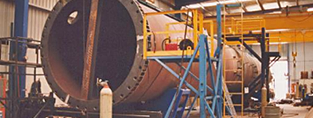
- (03) 5909 8218
- enquiry@fusionweld.com.au
The Definition of Shell and Tube Heat Exchangers
July 29, 2015

It makes life easier for engineering students when the title of a mechanism illustrates function so concisely. The label, shell and tube heat exchanger, implies the shape and form of a common industrial appliance. The shell is simply a pressure vessel and the tubes are a set of hollow conduits located within the shell. The purpose of this configuration is to place two different fluids close enough together so that the thermal properties of one fluid influences the other. Note, while the two energy carriers are influencing each other, the two fluids never come into contact.
An Introduction to Shell and Tube Heat Exchangers
The basic explanation mentioned above creates an image of one fluid flowing through the vessel and a separate fluid flowing through a network of tubes. Both the shell side and the tube side (technical terms that differentiate the subsystems) use inlet and outlet ports, thus there is a steady flow of the two fluids. The primary principle in this design involves the conductance of energy between the walls of the tubes and the fluid within the shell. The configuration of the tubes creates maximum cross-sectional area coverage between the two thermal components without creating a physical profile that would otherwise occupy enormous areas within an operational facility.
Naming the Relevant Parts of a Shell and Tube Heat Exchanger
- The tube stack
- The shell or hollow pressure vessel
- Plenums
- Baffles
- Header panel
The tube array is typically formed in U-sections, with the input pumping fluid through the input plenum. A plenum is simply the terminating port on the exterior of the shell, the point where the tube array penetrates the header and attaches to the exterior flow pipes. In the case of U-section tube arrays, the output plenum is located on the header with the input side located nearby. Straight tube models place the plenum ports at opposite sides of the shell.
There's little else to explain at this basic level other than energy constraints and pressure ratings. The baffles hold the tube array in place, with design specifications allowing room for expansion and contraction due to temperature variances. The shell must be rated for high pressure applications, especially when the device is used in chemical facilities and oil refineries. These industrial applications use both single-state and two-state profiles. The single phase version uses two fluid in the same state. Two hot liquids are common in this configuration. A two-state model occupies loftier engineering principles. It's here that liquids flow through the tube or shell side while a highly pressurized gas is pumped through the other side of the system.
Due to pressure and conductance considerations, copper and steel alloys are commonly used in the manufacturing of shell and tube heat exchangers.
Contact Details
Fusion - Weld Engineering Pty Ltd
ABN 98 068 987619
1865 Frankston Flinders Road,
Hastings, VIC 3915
Ph: (03) 5909 8218
Optimized by NetwizardSEO.com.au
Recent Posts
- Heat Exchanger Maintenance in Melbourne: Minimising Risk in Power Generation Facilities
- Compressed Hydrogen Storage Vessels: Material Selection, Design & Australian Standards
- Welding QA/QC in Oil & Gas Pressure Vessel Fabrication – Ensuring Code Compliance
- AS1210 vs ASME VIII Pressure Vessel Code: Key Differences for Australian Projects
- Mitigating Hydrogen-Induced Cracking in Pressure Vessels: Engineering and Material Strategies
- Storage Tank Solutions Australia: Field-Erected, Prefabricated & Self-Bunded Explained
- Reducing Environmental Risks: Self-Bunded Tanks in Australian Oil & Gas Operations
- Precision in Production: How Pressure Vessels Are Manufactured for Industrial Safety
- Shell & Tube Heat Exchangers: Improve Thermal Control & Energy Recovery in Petrochemical & Pharmaceutical Plants
- In-Service Inspection for Compressed Air Receivers for Power Plant Shutdown Prevention
- Power Plant Pipe Spooling Fabrication – Get Rapid, Code-Compliant Spools Ready for Installation
- Field Erected Tanks: Safe, Reliable On-Site Fuel Storage Solutions in Australia
Posts 2026
- Heat Exchanger Maintenance in Melbourne: Minimising Risk in Power Generation Facilities
- View all articles…
Posts 2025
- Compressed Hydrogen Storage Vessels: Material Selection, Design & Australian Standards
- Welding QA/QC in Oil & Gas Pressure Vessel Fabrication – Ensuring Code Compliance
- View all articles…
Posts 2024
- Large Process Vessels: Optimising the Design for Maximum Efficiency [2025]
- Pressure Equipment Management System Installation: Detect Equipment Faults Early
- View all articles…
Posts 2023
- Pressure Piping System Inspection: A Gift of Safety for the Holidays
- Deaerator Inspections by Fusion-Weld Engineering and How They Reduce System Downtime
- View all articles…
Posts 2022
- How Fusion Weld Keeps Up With AS-NZS ISO 9001:2008 Standard
- Boiler Equipment Safety Inspection During the Summer Season
- View all articles…
Posts 2021
- Avoid These Factors and Practices that Contribute to Sealing Damage in Pressure Vessels
- Do's And Don'ts Of Industrial Boiler Inspection And Maintenance From Fusion-Weld
- View all articles…
Posts 2020
- What are the Risks and Hazards Involved in Pressure Vessel Equipment?
- How to Know if Your Pressure Equipment Needs Repair or Replacement?
- View all articles…
Posts 2019
- Factors that Contribute to Pressure Vessel Failure
- Pressure Vessel Regulations in Australia: What are the Mandatory Requirements?
- View all articles…
Posts 2018
- Pros and Cons of Spherical vs. Cylindrical Pressure Vessels
- What are the Different Hazard Levels in Pressure Vessels?
- View all articles…
Posts 2017
- Transportable Pressure Vessels: The Importance of Inspection and Safety Checks
- Fracture Mechanics and Stress Analysis of Cracks in Pressure Vessels
- View all articles…
Posts 2016
Posts 2015
- What Are Deaerators & Feedwater Vessels?
- Precautions and Safety for Compressed Air Receiver Vessels
- View all articles…
Posts 2014
- Demonstrating In-process Inspection Procedures
- Static Grounding Practices and Standards
- View all articles…